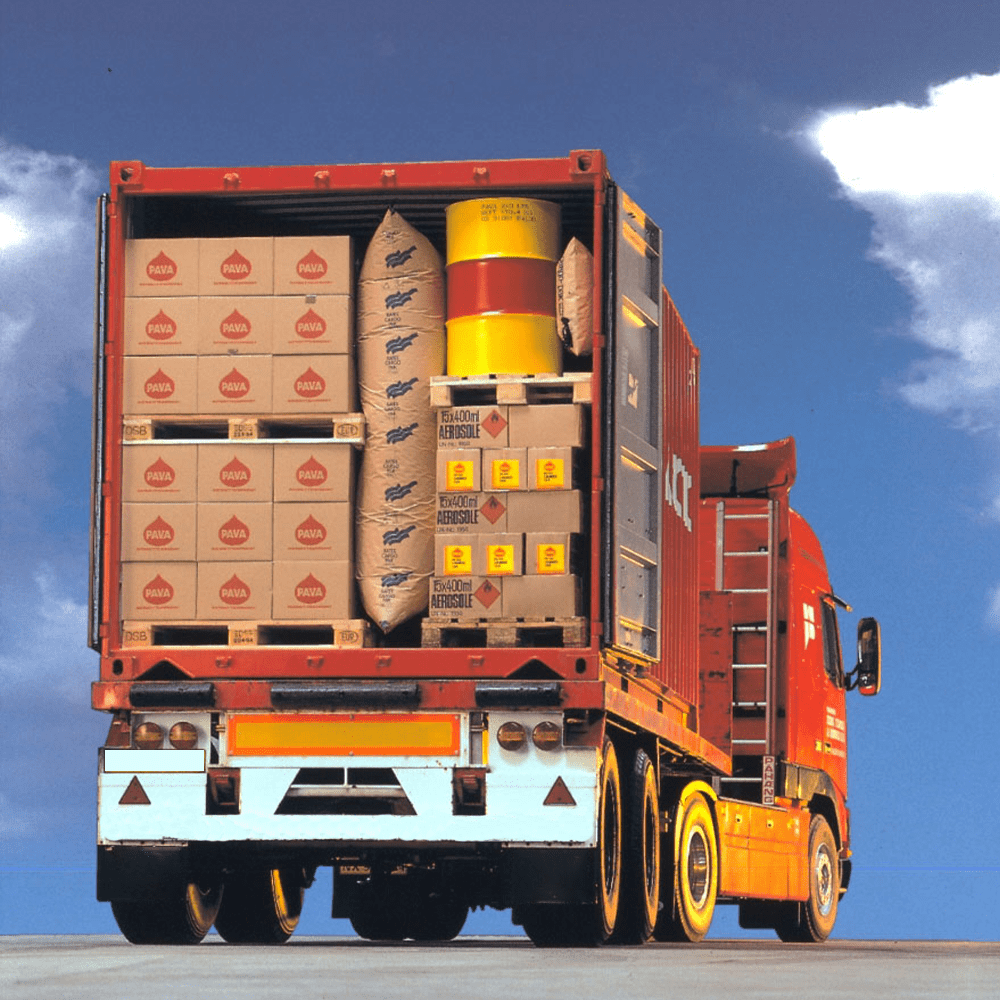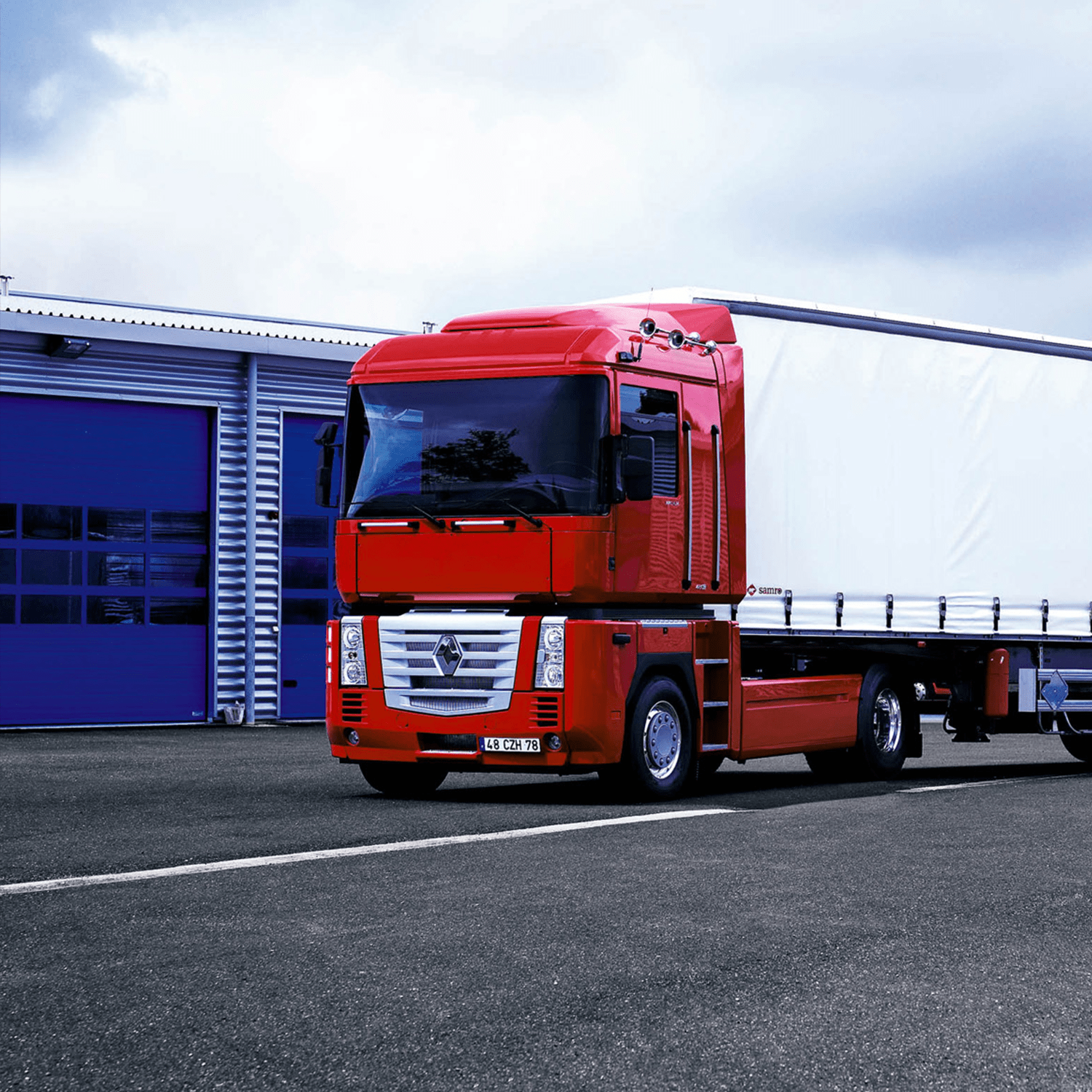What and who benefits from railway transportation?
Delivery by rail is the best choice primarily for suppliers of large or oversized cargo. Huge units of cargo are placed in the train cars, so the most reasonable option for the transportation of large consignments will be to order rail transportation.
A significant advantage of rail transportation is that it is not affected by the weather. After all, the train reliably protects the cargo from external factors.
Nowadays, rail transportation is the second most popular variety after road transportation. The reason for this may be the speed of delivery over long distances and low cost.
Railway transportation procedure
You may choose one of the four types of rolling stock that will be perfect fit for your cargo:
- Conventional covered railroad cars/gondola cars;
- Tanks;
- Containers of different capacities;
- Railway platforms, hoppers.
Incoterms 2010 (effective since 01.01.2011) is a set of international rules used in the global trade and recognized worldwide by government agencies, law firms, and merchants.
The scope of Incoterms 2010 covers the rights and obligations of the parties under the contract of sale in terms of the goods delivery.
What is the difference between Incoterms 2010 and the previous one, Incoterms 2000?
Incoterms 2010 provided for two new regulations, DAT and DAP, which can be used as multimodal. At the same time, 4 terms that were least used in practice were abolished, i.e. DAF, DES, DEQ and DDU.
*DAP – delivered at place, DAT – delivered at terminal.
• DAT replaces the term DEQ: the goods are provided to the buyer in unloaded form from the arriving vehicle.
• DAP replaces three terms – DAF, DES and DDU. It means that the seller has fulfilled his obligations when he has provided the buyer with the goods that are ready for unloading at the designated place.
Costs and risks on FOB, CFR and CIF delivery terms are redefined.
*FOB (free on board), CFR (cost and freight) and CIF (cost, insurance and freight).
According to the new Incoterms 2010, the transfer of risks is established after full shipment of cargo on board of the vessel.
Structure of Incoterms 2010 terms. Definition of abbreviations E, F, C, D
• Е – means that the seller has minimal obligations, limited to providing the goods at the disposal of the buyer;
• F – means that obligations are limited to sending the goods to the buyer when the main part of the delivery is not paid;
• С – means that the payment of the main part of the transportation shall be made in full. Responsibilities shall be transferred when the cargo arrives at the terminal;
• D – means the maximum scope of costs and risks vested on the seller. Obligations shall be transferred when the buyer has received the goods.
It is worth noting that the main obligations within the groups are somewhat different. For example, in group C (CIF and CIP) the seller must additionally insure the goods. In group D (DDP), he must pay import duties, and in groups F and D the differences are related to loading/unloading.
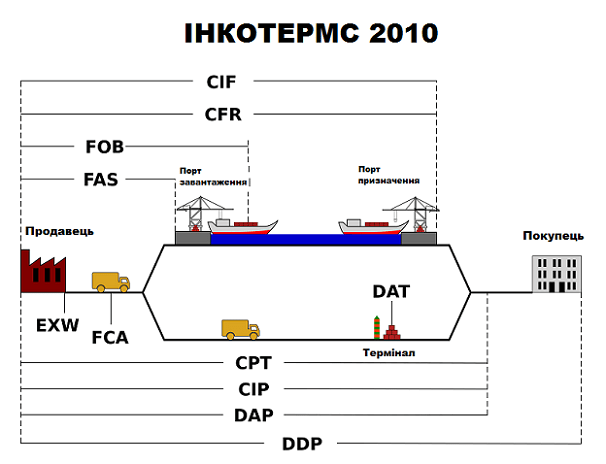
Incoterms 2010
Category E
Shipment
|
EXW |
any |
EX Works (... named place). |
Category F
The main transportation is not paid by the seller
|
FCA |
any vehicle |
Free Carrier (...named place) Transfer of |
|
FAS |
sea and |
Free Alongside Ship (... named port of shipment) |
|
FOB |
sea and |
Free On Board (... named port of shipment) Transfer of risks: From the moment of full loading on board of the vessel Export customs formalities: Seller's responsibility |
Category C
The main transportation is paid by the seller
|
CFR |
sea and |
Cost and Freight (... named port of destination) Transfer of risks: From the moment of full loading on board of the vessel Export customs formalities: Seller's responsibility |
|
CIF |
sea and |
Cost, Insurance and Freight (...named port of destination) Transfer of risks: From the moment of full loading on board of the vessel Export customs formalities: Seller's responsibility |
|
CIP |
all vehicles |
Carriage and Insurance Paid To (... named place of destination) Transfer of risks: At the time of delivery/transfer to the carrier Export customs formalities: Seller's responsibility |
|
CPT |
all vehicles |
Carriage Paid To (...named place of destination) Transfer of risks: At the time of delivery/transfer to the carrier Export customs formalities: Seller's responsibility |
Category D
Delivery
|
DAT |
all vehicles |
new! |
|
DAP |
all vehicles |
new! Delivered At Piont (...named point of destination) Transfer of risks: At the time of delivery of the goods to the point specified by the buyer Export customs formalities: Seller's responsibility Import customs formalities: Buyer's responsibility |
|
DDP |
all vehicles |
Delivered Duty Paid (...named place of destination ) Transfer of risks: At the moment the goods are placed at the disposal of the buyer Export customs formalities: Seller’s responsibility Import customs formalities: Seller’s responsibility |
|
DDU |
all vehicles |
Excluded from Incoterms 2010 Delivered Duty Unpaid (... named place of destination) |
|
DAF |
all vehicles |
Excluded from Incoterms 2010 Delivered At Frontier (... named place) |
|
DEQ |
sea and inland waterway transportation |
Excluded from Incoterms 2010 Delivered Ex Quay (...named port of destination) |
|
DES |
sea and inland waterway transportation |
Excluded from Incoterms 2010 Delivered Ex Ship (... named port of destination) |
WHAT UKRAINIAN ENTREPRENEURS NEED TO KNOW ABOUT INCOTERMS 2010
When does Incoterms 2010 become effective?
Incoterms 2010 (International Commercial Terms) was published by the International Chamber of Commerce and has been widely used in international trade since January 1, 2011 along with the previous collections of rules, including the most popular Incoterms 1990 and Inco. Ukraine has a special situation with the entry of the updated version of the International Rules for the Interpretation of Commercial Terms into force.
Incoterms in Ukraine are certain rules prescribed by law, which will become mandatory in our country (for state regulatory and control authorities) 10 days after their publication in Uriadovyi Kurier. As of today, according to the Decree of the President of Ukraine on the Application of International Rules of Interpretation of Commercial Terms dated 04.10.94 N 567/94, the version of 2000 is mandatory. Application of the new Incoterms 2010 is not yet determined by applicable laws and they have not been translated into Ukrainian yet.
How to apply Incoterms 2010 during the customs clearance of goods
New delivery terms (DAT and DAP) in Incoterms 2010 have already been included in the Classifier of Delivery Terms used during the declaration of goods (Order of the State Customs Service of Ukraine dated 31.12.2010 N 1572). At the same time, the State Customs Service of Ukraine warns that the "Terms of delivery under DAT and DAP codes before the official publication of Incoterms 2010 cannot be used when concluding foreign economic agreements (contracts) under the law of Ukraine...". This means that the use of Incoterms 2010 depends on the law applicable to the contract.
Rules for determining the law applicable to a foreign trade agreement
Article 6 of the Law on Foreign Economic Activity states that either the law chosen by the two parties to the contract or the law of the seller's country should be applied.
It is worth noting that if the foreign economic agreement was withdrawn from the legal field of Ukraine, it is possible to rely on Incoterms 2010 and indicate new delivery codes in the customs declaration.
Should you worry about Incoterms 2010
It all depends on the conditions prescribed in your contract. If you refer to previous versions of Incoterms or do not use these rules at all, you can ignore the changes that come into force.
In case you do refer to Incoterms, please, note that since 01.01.2011 any reference to Incoterms in the contract signed on or after January 1 will mean a reference to Incoterms 2010 (unless, of course, the parties agree otherwise). So in this case it is required to think what amendments to make to comply with Incoterms 2010.
Thus, it is required to:
- check the existing contracts;
- made amendments, taking into account Incoterms 2010;
- make the required edits to the standard contract that will be used in the future.
The key amendments you need to know about
1. Four terms, DAF, DES, DEQ and DDU, disappeared and two new terms of delivery, DAP and DAT, were introduced.
2. Two classes of Incoterms were created:
- rules for any type of vehicles;
- rules for sea and river transportation (Incoterms 2000 had four classes).
3. The rules now apply to both international and domestic deliveries.
4. A reference to the use of electronic records has been introduced.
5. Insurance coverage has been revised taking into account amendments made to the Institute Cargo Paragraphs (Institute of London Insurers).
6. Clearly distributed costs at the terminal.
Why amending Incoterms 2010?
The decision to reduce the number of conditions was due to the fact that traders often chose incorrect or confusing conditions that lead to contradictory contracts. The new conditions do not depend on the chosen transport. When determining the customs value of goods delivered in accordance with the new terms, it should be taken into account that under the DAT terms, the cost of goods includes the cost of transportation to the terminal agreed by the parties and unloading at such terminal (excluding the insurance costs).
Under DAP, the invoice value includes only the cost of transportation to the place specified by the parties without unloading and insurance. The determination of the customs value of imported goods is facilitated by the fact that the new rules introduce the obligation of both parties to provide all required information upon request in cases of customs import-export clearance. The previous version of Incoterms did not oblige to such type of cooperation.
Source: "Customs Consultation"
Technical characteristics of sea containers for dry cargo: 20, 40 and 45 foot containers.
|
Parameters |
20-foot standard |
20-foot high container |
40-foot standard |
40-foot high container |
40-foot high wide |
45-foot |
45-foot |
|
20' DC |
20' HC |
40' DV |
40' HC |
40' HCPW |
45' HCPW |
45' HCPW |
|
|
External dimensions |
|||||||
|
Length, mm |
6058 |
6058 |
12192 |
12192 |
12192 |
13716 |
13716 |
|
Width, mm |
2438 |
2438 |
2438 |
2438 |
2500 |
2500 |
2500 |
|
Height, mm |
2591 |
2896 |
2591 |
2896 |
2896 |
2750 |
2896 |
|
Internal dimensions |
|||||||
|
Length, mm |
5905 |
5905 |
12039 |
12039 |
12039 |
13513 |
13513 |
|
Width, mm |
2350 |
2350 |
2350 |
2350 |
2432 |
2444 |
2444 |
|
Height, mm |
2381 |
2693 |
2372 |
2693 |
2693 |
2549 |
2670 |
|
Doorway |
|||||||
|
Width, mm |
2336 |
2340 |
2336 |
2340 |
2432 |
2416 |
2416 |
|
Height, mm |
2291 |
2597 |
2291 |
2597 |
2597 |
2439 |
2580 |
|
Characteristics |
|||||||
|
max Gross, kg |
24000-30480 |
30480 |
28800-30480 |
30480-32500 |
30480-35000 |
34000 |
34000 |
|
Tare weight, kg. |
2145-2370 |
2340 |
3640-4000 |
3740-4200 |
4200-4400 |
4180 |
4250-5080 |
|
Payload, kg. |
21630-28335 |
28140 |
24800-26840 |
26280-28650 |
26280-30720 |
29820 |
28920-29750 |
|
Volume, cubic meters |
33-33,2 |
37,5 |
67,3-67,8 |
75,6-76,5 |
78,8-79,3 |
85,1 |
88,7-89,5 |
|
Stacking, tiers |
86400, 9 |
86400, 9 |
86400, 7 |
86400, 7 |
86400, 5 |
86400, 5 |
86400, 5 |
|
Number of placed euro pallets (1200x800 mm), pcs |
11 |
11 |
25 |
25 |
30 |
33 |
33 |
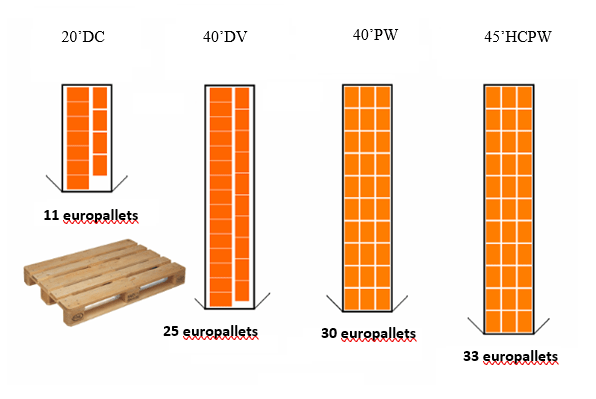
REEFER CONTAINER
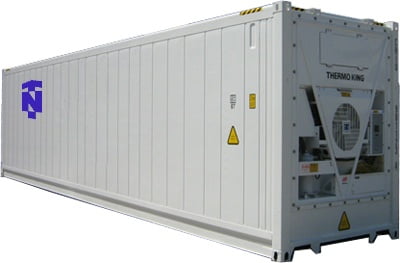
20' Refrigerated Container
|
40' High Cube Refrigerated Container
|
OPEN TOP CONTAINER

20' Open Top Container
|
40' Open Top Container
|
FLAT RACK CONTAINER

20' Flat Rack Container with Collapsible End
|
40' Flat Rack Container with Collapsible End
|

20' Flat Rack Container with Four Freestanding Posts
|
40' Flat Rack Container with Four Freestanding Posts
|
TANK CONTAINER 20 FEET (20′ TANK CONTAINER)
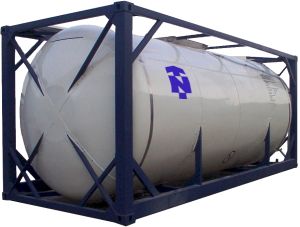
External length, m |
6,058 |
External width, m |
2,438 |
External height, m |
2,591 |
Container weight, kg |
3385 |
Carrying capacity, kg |
32615 |
Capacity, cubic meters |
24 |
*Container parameters may vary depending on the manufacturer.
Import/export by rail is the fastest and safest way. Transportation shall be carried out using different types of freight cars:
- tanks;
- dump cars;
- covered cars;
- gondola cars;
- platforms;
- bunker-type cars;
- ref-cars, etc.
Let us consider several basic types of rail cars and their characteristics.
Covered car
This is a type of railway car closed on all sides. It is used to transport goods that need careful handling and to preserve their integrity.
Loading and unloading shall be carried out through the doors in the side walls.
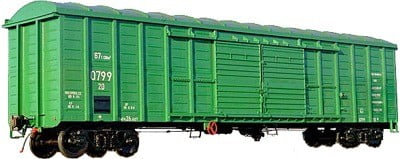
| Interior dimensions | Door dimensions |
Weight |
Volume | Download | |
| Covered car | mm | mm | t | m3 | t |
| Length | 15724 | 26,0 | 138,0 | 68,0 | |
| Width | 2764 | 3802 | |||
|
Height |
3050 | 2334 |
*parameters may vary depending on the model and manufacturer.
Gondola car
Gondola cars are designed for cargoes that do not need protection from external factors. They are characterized by high sides and do not have a roof, which allows to fully mechanize the loading.
For transportation of bulk cargoes there are gondola cars with hatches in the floor, which allow to speed up the unloading process.

| Interior dimensions | Door dimensions | Weight | Volume | Download | |
| Gondola car | mm | mm | t | m3 | t |
| Length | 12690 | 23,0 | 75,2 | 71,0 | |
| Width | 2890 | ||||
| Height | 2050 |
*parameters may vary depending on the model and manufacturer.
Hopper
This is a kind of gondola car with a self-unloading functionality. It is used for transportation of grain, fertilizers, cement, coal, peat and other bulk cargoes. To protect the cargo from precipitation, covered hoppers are used with loading hatches on the roof.

| Interior dimensions | Door dimensions | Weight | Volume | Download | |
| Hopper | mm | mm | t | m3 | t |
| Length | 23,0 | 81,0 | 70,0 |
*parameters may vary depending on the model and manufacturer.
Platform
Open car for transportation of long and single-piece cargoes, machinery, equipment, containers and even bulk cargoes.
Platforms can be versatile and specialized.
Versatile ones have a strong steel frame and folding side and end boards, while specialized ones do not have sides and are equipped with special devices for securing cargo, as well as for comfortable loading/unloading.
Carrying capacity of the platforms: approximately 60-75 tons.

| Interior dimensions | Door dimensions | Weight | Volume | Download | |
| Platform | mm | mm | t | m3 | t |
| Length | 13300 | 23,5 | 71,0 | ||
| Width | 2770 | ||||
| Height | 400 |
*parameters may vary depending on the model and manufacturer.
Tank car
These are cars of cylindrical shape. They can be framed or frameless. This type of cars is used for the transportation of liquid cargoes, liquefied gases, powdered materials, oil, food products, etc.

| Interior dimensions | Door dimensions | Weight | Volume | Download | |
| Tank car | mm | mm | t | m3 | t |
| Length | 27,0 | 83,0 | 67,0 |
*parameters may vary depending on the model and manufacturer.
Hopper type freight cars
Covered cars with a hopper are designed for transportation of bulk and viscous cargoes: flour, grain, petroleum coke, petroleum bitumen, etc.
Dumpcar
Dump car. It is used for the transportation and mechanized unloading of bulk and bulky cargo.
Key specifications of freight cars:
- tare (weight of an empty car);
- carrying capacity (maximum weight that can be transported therein);
- body volume;
- area;
- length and other linear dimensions.
International consignment note CMR
CMR accompanies the contract for the international carriage of goods by road. To use the consignment note, it is sufficient that at least one of the countries between which the delivery is carried out has adopted the Convention on the Contract for the International Carriage of Goods by Road (CMR).
Filling procedure:
Column 1. Indicate the consignor company, its full address, country, city, zip code, street, and house number. If the goods are sent to Russia on behalf of the contract holder by a third company, the name of this company shall be indicated and a note shall be made: "on behalf of". For example, "company B" (consignor) on behalf of "company A" (contract holder).
Column 2. The name of the consignee company, its full address, country, city, zip code, street, and house number shall be indicated.
Column 3. Address of the place of final unloading of the goods (warehouse of the consignee company).
Column 4. Address of the place of loading of goods and date of loading.
Column 5. The numbers of invoices (invoices, proforma invoices), TIR carnet number, if there are numbers of certificates (veterinary, phytosanitary, conformity, etc.).
Columns 6, 7, 8, 9, 10, 11, 12. The number of places, type of packaging, product names, HS codes, gross weight shall be indicated.
Column 13. An important column. The consignee's customs authority (customs office, customs post and customs post code), temporary storage warehouse or customs warehouse, its address and license number (preferably indicating the expiration date of the license) shall be indicated.
Column 15. The terms of delivery according to Incoterms 2010 shall be indicated.
Column 21. Date of completing the CMR.
Columns 16, 17. The name of the carrier, its address shall be indicated. In this column the carrier puts his stamp.
Column 20. For the consignee's notes. Date of the cargo receipt and printing date.
Columns 25, 26. License plate numbers of the tractor and trailer.
Comment to fill in:
Paragraph 1 indicates the details of the consignor (name, address, country). In addition to these data, the carrier shall specify the phone number and surname of the contact person of the consignor in the case any questions arise during transportation (at the customs or at the consignee). Paragraph 2 contains the details of the consignee (name, address, country). It is also required to have the consignee's phone number to resolve issues at the customs upon entry into the country, to find the consignee's office in case of poor command of the consignee's national language. Paragraph 3 indicates the address of the unloading place. If the address of the unloading place is the same as the consignee’s address, the carrier should not have any special questions. However, as a rule, 50% of consignors specify different unloading place and consignee’s address. This is because the cargo is delivered directly to a branch, warehouse, or store. In this case, the carrier must have the phone number of the place of unloading, and if the consignee and the place of unloading are in different cities, then the carrier must call the cargo consignor to clarify the route and find out whether he should arrived at the consignee’s address first or go directly to the address of the unloading place. Paragraph 4 indicates the place and date of the cargo loading. Paragraph 5 contains a list of documents to be attached.
These include:
- Invoice;
- Shipping specification;
- Quality certificate if the goods are of industrial origin;
- Veterinary certificate if the goods are of animal origin;
- Quarantine certificate if the goods are of plant origin;
- Certificate of origin;
- Loading certificate;
- These documents are described in paragraphs 2-8.
In paragraph 6, signs and numbers indicating the class and subclass of hazardous goods transported, determined according to the ADR Convention, shall be specified. Features of the carriage of hazardous goods are described in paragraph 2.
Paragraph 7 contains the number of cargo places. As a rule, up to 90% of all goods transported by road are placed on pallets and it the carrier prefers indicating the number of pallets in paragraph 7. This number can be checked easily by determining the number of rows of pallets and multiplying them by two (there are two pallets per row in the cargo compartment).
Paragraph 8 indicates the type of cargo packaging (cardboard boxes, wooden boxes, metal or plastic barrels, canvas or polyethylene bags, etc.)
Paragraph 9 indicates the name of the cargo.
Paragraph 10 indicates the cargo code by classification.
Paragraph 11 indicates the gross weight in kilograms, that is, the weight of the cargo with packaging, and paragraph 12 – the volume of the cargo in cubic meters.
Paragraph 13 – consignor’s instructions (customs and other processing). This paragraph contains the details of the contract of sale of the goods (number and date of the contract) and, if a license or permit for the export of goods is required, the details of these documents shall be indicated. The box of paragraph 13 shows an envelope. What does it mean? The fact is that one copy of the contract of sale of the goods, as well as a license or permit for the export of goods from the country must be provided at the customs office where the customs clearance of the goods will take place.
The image of the envelope should remind the shipper and the carrier that these documents must be at the customs, and if they are not sent for some reason, the shipper will transfer them in an envelope with the carrier. At the bottom of paragraph 13 the declared value of the cargo shall be indicated. Article 23 (paragraph 3) of the CMR Convention establishes a limit of the carrier's liability restricting the amount of compensation to $12 per kilogram of gross weight shortage (8.33×1.46 = $12.16). However, paragraph 6 of Article 23 provides that a more significant amount of compensation may be claimed from the carrier if the value of the goods has been declared in accordance with Articles 24 and 26.
In the case of declaration of the value of the cargo exceeding the limit specified in paragraph 3 of Article 23, the declared value replaces this limit. The Convention stipulates that upon declaration of the value of the cargo exceeding the liability limit, the carrier is entitled to additional freight to pay for the escort convoy.
In item 14, the state number of the semitrailer or container is indicated in case of their export from abroad after a temporary stay there. For example, if the semitrailer was temporarily left abroad for some reason (for repair in connection with an accident or after diagnostic control), then when it is exported to the country of registration, the license plate number shall be recorded in paragraph 14 of CMR.
*It is executed in three counterparts: for the consignor, carrier, and consignee.
*The document shall be signed by the consignor and the carrier.
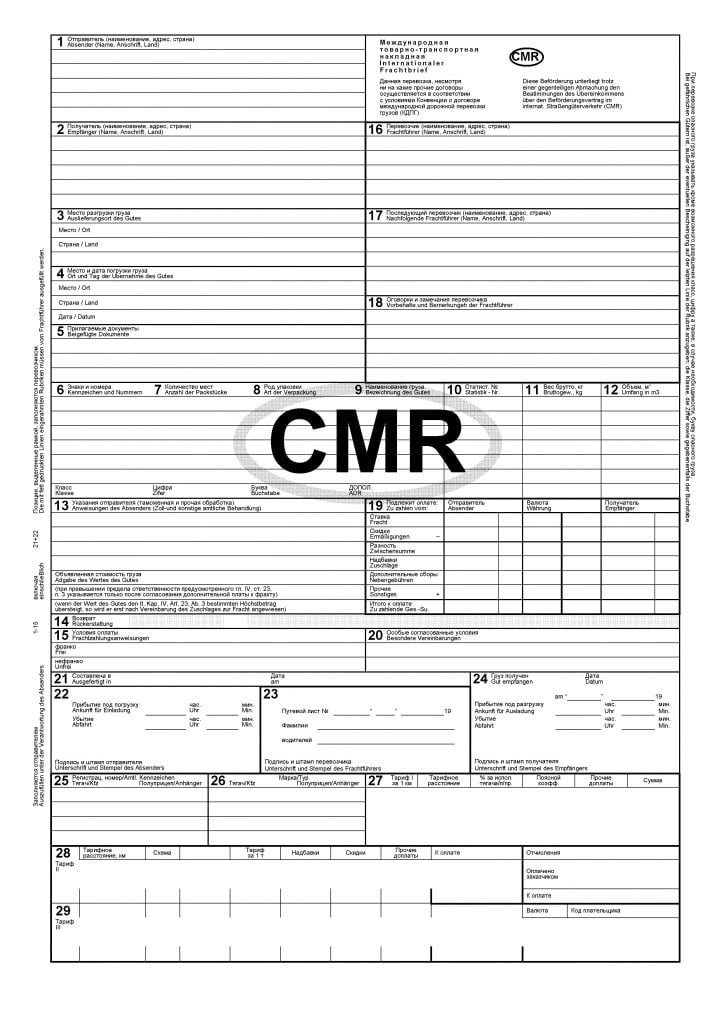
EX-1 declaration
Declaration for goods manufactured in EU countries and exported outside the EU. EX-1 allows avoiding local VAT. The document shall be executed by representatives of the carrier or manufacturer (supplier) having a relevant license. The EX-1 declaration shall be presented when crossing the borders of the European Union.
T1 declaration
Declaration for accompanying the non-EU goods to the EU. It shall be executed by authorized representatives of the supplier or carrier at customs warehouses, at the EU border, if the goods are imported by land, and during transportation by air it can be executed directly on board of the aircraft.
TIR (Transports International Routiers) system
The main purpose of the TIR system is to simplify the crossing of state borders for carriers, and to establish transparent rules for the customs authorities of the countries where the system is adopted. TIR works in more than 50 countries, and the customs authorities of these countries have authorized more than 4,000 carriers to work under this system.
System operation rules:
- cargoes are sealed during transportation and any access to them is excluded (due to the use of seals and special containers);
- the cargo is accompanied by a TIR Carnet (International Road Transport).
TIR Carnet is a document accompanying the cargo during transportation between the customs offices of the consignee and the consignor. The document shall be issued by authorized organizations (in Ukraine, it is the Association of Road Carriers) and looks like a book containing 4-14 sheets. The first sheet is fixed, and the inner ones shall be torn off when passing the next customs.
TIR CARNET is an international customs document giving the right to transport the goods across state borders in customs-sealed car bodies or containers under a simplified customs clearance procedure. The document covers road and rail transportation of goods (carried out in vans, trailers, semi-trailers and containers) between the states that have recognized the Customs Convention on the International Transport of Goods under Cover of the International Road Transport Carnets (TIR) 1959 and 1975 (see paragraph 4). All road vehicles must have appropriate permits issued by the competent authorities for their use.
Now increasingly more goods are transported using TIR. This speeds up delivery and reduces transportation costs.

Bill of lading is an invoice in sea transportation.
It is a document accompanying the cargo during sea transportation.
Functions and purpose of the bill of lading:
- it confirms receipt of the cargo by the carrier and description of the cargo condition;
- it serves as a consignment note and a shipping document;
- it confirms the contract for the carriage of goods.
The bill of lading shall be issued by the carrier to the consignor and certify the transfer of the goods for transportation. It is issued in three counterparts: for the consignor, carrier, and consignee. In this case, one of the copies is stamped "Original", and the other two – "Copy". The document stamped "Original" shall be sent to the consignee and allow receiving the cargo.
Data to be entered in the bill of lading:
- vehicle name;
- consignee’s details;
- consignor’s details;
- carrier’s details;
- data on the place of receipt and loading;
- cargo destination;
- time and place of the document issuance.
Airwaybill.
Document for air transportation.
An air waybill cannot be a document of title, but serves to confirm the existence of a contract of carriage and transfer of cargo to the carrier. On the other hand, an air waybill can serve as a customs declaration.
The document is prepared by the consignor (or his agent) under the invoice in three counterparts:
1. For the carrier. It shall be signed by the consignor and kept by the carrier;
2. For the consignee. It shall be signed by the consignor and the carrier and kept by the consignee;
3. For the consignor. It shall be delivered to the consignor of the goods and confirm the delivery and acceptance of the goods by the consignee.
Data entered into the airwaybill:
- departure and arrival points;
- list of documents attached to the consignment note;
- cargo value;
- the cost of freight;
- date of execution.
*The consignor shall be fully responsible for the accuracy of the data in the airwaybill
Types of invoices:
MAWB: It shall be issued by the airline and contain information about the agents or shipper in the country of departure and the country of receipt.
HAWB: It shall be issued by the agent and contain full information about the consignor and consignee based on the invoice attached to the cargo.
*The number of the waybill is always unique, and this number can be used to track the cargo.
ADR (from French Accord Dangereuses Route) is a European agreement on the international transport of hazardous goods.
Hazardous goods are substances posing a risk of harm to health, human life and/or the environment during transportation. The transportation of hazardous goods, except for ADR, is regulated in accordance with the Temporary Instruction on the Transportation of Hazardous Goods by Road of the Ministry of Transport.
The ADR Agreement is valid in all EU countries, as well as in Kazakhstan, Azerbaijan, Morocco, Russia (similar name of ADR).
Hazardous goods by nature and degree of danger: classification
Class 1 are explosive materials that may explode or catch fire. And devices containing explosives and detonating means intended to produce a pyrotechnic effect;
Subclasses
1.1 - pyrotechnic, explosive substances/products with a mass explosion hazard (instantaneous coverage of the entire cargo);
1.2 - pyrotechnic, explosive substances/products that do not explode in bulk;
1.3 - pyrotechnic, explosive substances/products that have a fire hazard with or without a slight explosive effect;
1.4 - pyrotechnic, explosive substances/products that carry a slight risk of explosion during transportation only in the case of initiation or ignition, which do not destroy devices and packages;
1.5 - explosives with a mass explosion hazard that are so insensitive that initiation or transition from combustion to detonation is unlikely during transportation;
1.6 - articles containing substances insensitive to detonation and characterized by a low probability of accidental initiation;
*Explosive mixtures of gases, vapours and dusts are not considered as explosives.
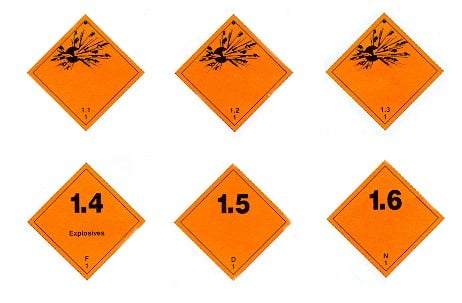
Class 2 are compressed, liquefied by cooling and dissolved under pressure gases that meet at least one of the following conditions:
- absolute vapor pressure at 50 °C is equal to or higher than 3 kgf/cm2 (300 KPa);
- the critical temperature is below 50 °C.
According to the physical state of gases are divided into:
- Brief. The critical temperature is below -10 °C;
- Liquefied. The critical temperature is equal to or above -10 °C, but not lower than 70 °C;
- Liquefied. The critical temperature is equal to or above 70°C;
- Dissolved under pressure;
- Liquefied by supercooling;
- Aerosols and compressed gases that are subject to special regulations.
Subclasses
2.1 - non-flammable gases;
2.2 - non-flammable poisonous gases;
2.3 - flammable gases;
2.4 - flammable poisonous gases;
2.5 - chemically unstable;
2.6 - chemically unstable poisonous.

Class 3 are flammable liquids, mixtures of liquids, as well as liquids containing solids in solution or suspension, which emit flammable vapors with a flash point in a closed crucible at 61 °C and below.
3.1 - flammable liquids with a low flash point and liquids with a flash point in a closed crucible below -18 °C or having a flash point in combination with other hazardous properties other than flammability;
3.2 - flammable liquids with a medium flash point – liquids with a flash point in a closed crucible from -18 to +23 °C;
3.3 - flammable liquids with a high flash point – liquids with a flash point from 23 to 61 °C inclusive in a closed crucible.

Class 4 are flammable substances and materials, other than those classified as explosives, which are capable of igniting during transportation from external sources of ignition due to friction, moisture absorption, spontaneous chemical transformations, as well as when heated.
4.1 - flammable solids that can ignite from short-term exposure to external ignition sources (sparks, flames or friction) and burn intencely;
4.2 - flammable substances that can spontaneously heat up and ignite under normal transportation conditions;
4.3 - substances that emit flammable gases when interacting with water.

Class 5 are oxidizing substances and organic peroxides, which can release oxygen, support combustion, and in certain conditions or mixtures with other substances cause spontaneous combustion and even explosion.
5.1 - oxidizing substances. They are not flammable in themselves, but contribute to the flammability of other substances and release oxygen during combustion, thereby increasing the fire intensity;
5.2 - organic peroxides. Most of them are flammable, can act as oxidizing agents and interact hazardously with other substances. Some of them are flammable and sensitive to impact or friction.

Class 6 are poisonous and infectious substances that can cause poisoning, disease or even death.
6.1 - poisonous (toxic) substances that cause poisoning when inhaled (vapors, dust), ingested or in direct contact with the skin;
6.2 - substances and materials containing pathogenic microorganisms that are hazardous for humans and animals.
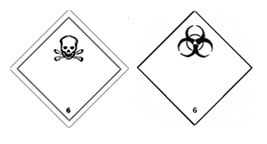
Class 7 are radioactive substances with specific activity over 70 kBq/kg (nCi/g).
Class 8 are corrosive substances that cause damage to the skin, eyes, respiratory tract, cause corrosion of metals and damage vehicles, buildings, cargoes, and can also create a fire when interacting with organic materials or certain chemicals.
8.1 - acids;
8.2 - bases;
8.3 - caustic and corrosive substances.
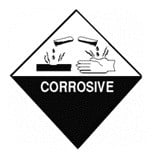
Class 9 are substances with a rather low hazard during transportation. They do not belong to any of the previous classes, but require certain rules for transportation and storage.
9.1 - solid, liquid combustible substances and materials that can become hazardous under certain conditions (flammable liquids with a flash point from +61 °C to +100 °C in a closed container, fibers and other similar materials);
9.2 - substances that become corrosive under certain conditions.
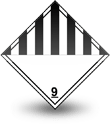
List of groups of particularly hazardous goods according to GOST 19433-88
- Explosives;
- Radioactive substances;
- Non-flammable non-poisonous oxidizing gases;
- Oxidizing poisonous gases;
- Poisonous gases, oxidizing or corrosive;
- Flammable liquids with a flash point of less than minus 18 °C, poisonous;
- Flammable liquids with a flash point of less than minus 18 °C, corrosive;
- Flammable liquids with a flash point of from minus 18 °C to plus 23 °C, corrosive;
- Flammable liquids with a flash point from minus 18 °C to plus 23 °C, poisonous and/or corrosive;
- Flammable solids are caustic and/or corrosive;
- Flammable solids that self-decompose at a temperature not exceeding 50 °C with a risk of package rupture;
- Spontaneously combustible solids, poisonous;
- Flammable solids, caustic and/or corrosive;
- Substances emitting flammable gases when interacting with water, flammable;
- Substances emitting flammable gases when interacting with water, flammable and poisonous;
- Substances emitting flammable gases when interacting with water, flammable, caustic and/or corrosive;
- Oxidizing substances, poisonous, caustic and/or corrosive;
- Organic peroxides, explosive, self-decomposing at temperatures not exceeding 50 °C;
- Organic peroxides self-decomposing at temperatures above 50°C;
- Explosive organic peroxides;
- Organic peroxides without additional hazards;
- Organic peroxides are corrosive to the eyes;
- Organic peroxides, flammable;
- Organic peroxides, flammable, corrosive to the eyes;
- Poisonous substances, volatile, without additional hazards;
- Poisonous substances, volatile, flammable, with a flash point slightly above 23 °C;
- Poisonous substances, volatile flammable, with a flash point of more than 23 °C, but not exceeding 61 °C;
- Toxic substances, volatile, caustic and (or) corrosive;
- Caustic and (or) corrosive, acidic, toxic and oxidizing;
- Caustic and (or) corrosive, having acidic properties, oxidizing;
- Caustic and (or) corrosive, having acidic properties, poisonous;
- Caustic and (or) corrosive, having basic properties, flammable, with flash a point from 23 °C to 61 °C;
- Caustic and (or) corrosive, having basic properties, oxidizing;
- Caustic and (or) corrosive various, poisonous and oxidizing;
- Caustic and (or) corrosive various, flammable, with a flash point of not exceeding 23 °C;
- Caustic and (or) corrosive various, flammable, with a flash point from 24 °C to 61 °C;
- Caustic and (or) corrosive various, poisonous.
In addition to this agreement, there are the other agreements for the transportation of hazardous goods in Europe:
IMDG is a contract for the carriage of hazardous goods by sea.
ICAO-TI is a contract for the carriage of hazardous goods by air.
RID is an agreement on the carriage of hazardous goods by rail. A special UN list of hazardous substances (containing more than 3000 items) has been created. Each hazardous substance included in this list has a four-digit identification number according to the UN list of hazardous substances. It can be used to find out the exact name of the hazardous substance being transported.
It is allowed to transport a hazardous substance of one class only at a time according to the rules intended for it.
These classes of hazardous goods are formed by:
1. The main hazard posed by the substance during its transportation.
2. Physical state of the substance during transportation (solid, liquid, gaseous).
If a substance features more than one hazard, the contract shall specify the main and additional hazards. Artificially created hazards shall not be taken into account.
The entire list of hazardous substances is divided into 13 classes with the numbering from 1 to 9.
Types of hazards
- Explosive hazard;
- Fire hazard;
- Toxicity;
- Causticity (corrosiveness);
- Radioactivity;
- Oxidation.
Cargoes are divided into hazard classes according to the ADR contract classification:
Class 1 - explosive materials and objects;
Class 2 - compressed, liquefied and dissolved gases under pressure;
Class 3 - flammable liquids;
4.1 class - flammable solids;
4.2 class - flammable substances;
4.3 class - substances emitting flammable gases when in contact with water;
5.1 class - oxidizing substances;
5.2 class - organic peroxides;
6.1 class - toxic substances;
6.2 class - animal by-products and infectious substances;
Class 7 - radioactive materials;
Class 8 - corrosive substances;
Class 9 - other hazardous substances.
ADR documents
Entries to consignment notes. The consignment note must be written in the state language of the consignor. If this language is not English, French, German, it shall be additionally written in one of them.
When recording the name of the hazardous goods transported in the consignment note, the following information shall also be provided:
- UN... (or ANO...) identification number (example: 1831).
- full name of the hazardous goods.
- class of the main hazard (called the number of the main hazard symbol) and the class of additional hazard, if any (indicating the number of the additional hazard symbol in brackets, e.g. 8 (6.1)), and the packaging group, if any.
Hazardous waste
Hazardous waste containing substances on the UN Hazardous Goods List must be transported as hazardous goods. Example of entry: Waste, UN 1125, butylamine, 3 (8), II. Written instruction for the driver transporting hazardous goods – Emergency Card. This card shall be drawn up by the consignor of the cargo and handed over to the driver before loading.
This card shall be drawn up for each hazardous goods or group of hazardous goods with the same hazard (if the goods belong to the same class with the same hazard). This card must be kept in the cab of the vehicle in an accessible place (for example, in Sweden it is kept in the driver's door pocket).
This card is needed for the driver and rescue services as it contains information about the hazardous goods transported and emergency response actions. The card must be issued in the languages of the countries crossed by the route of transportation in a language understandable to the driver (in each language of the countries included in the ADR agreement). The consignor shall agree on the route with the carrier to check the languages of the card. He informs the carrier in advance about the cargo, route, additional means of protection and equipment. The driver shall not be responsible for the content of the card.
Types of packaging and labeling
The cargo consignor shall choose the packaging of hazardous goods. Double and non-disassemblable packaging shall be used. If the packaging is disassemblable, then it is combined. An IBC (Intermediate Bulk Container), a container with an average capacity up to 3000 liters, is often used. Such containers are considered packages.
It is required to check the labeling of the cargo and the availability of a hazard sign, i.e. a diamond with a rib length slightly exceeding 100 mm. It is obligatory to place all hazard signs on one side of the package. Reliability of packaging shall be indicated by Latin letters X, Y and Z, where X is very reliable.
Packing groups I, II, III. Y - simply reliable. Packing group II and III. Z – with satisfactory reliability. The packing group is III only. It is required to compare the packing group and reliability.
|
UKRAINE CHOP (Transcarpathian region) |
HUNGARY ZAHONY (HU724000) |
|
UKRAINE UZHHOROD (Transcarpathian region) |
SLOVAKIA VYSNE NEMECKE (SK532100) |
|
UKRAINE DIAKOVO (Transcarpathian region) PORUBNE (Chernivtsi region)
|
ROMANIA HALMEU (ROCJ4310) SIRET nr 46 / SIRET (ROIS8200) |
|
UKRAINE SHEHYNI (Lviv region) |
POLAND MEDYKA (PL401030) |
|
UKRAINE HREMYACH (Chernihiv region) |
RUSSIA POGAR |
|
UKRAINE NOVI YARYLOVYCHY (Chernihiv region) |
BELARUS NOVA HUTA |
|
UKRAINE MAMALYHA (Chernivtsi region) |
MOLDOVA CRIACENI BRICENI MYRNE |


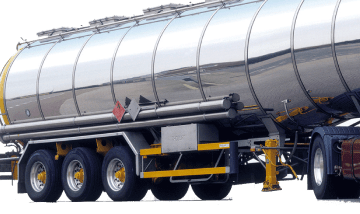
 EN
EN

 We provide calculation within 15 minutes
We provide calculation within 15 minutes


